Class 7 Exam > Class 7 Notes > English Grammar Class 7 > The Active And Passive Voice
The Active And Passive Voice | English Grammar Class 7 PDF Download
Rules for the Change of Voice
- When a verb is changed from the Active into Passive, the Object of the Active Verb becomes the Subject of the Passive Voice.
- Nominative Case of the Pronoun is changed into Objective Case.
- Only transitive verbs have passive voice.
- Change the verb into third form and put proper form of “to be” (is, am, are, was, were, be, been, being) before if according to the tense of the main verb in the Passive Voice and the number (singular/plural) of the new subject.
- By is used with the agent of action (= doer of the action). But it has to be kept in mind that where action is very important and the agent is unimportant, the preposition “by” and the agent are left out.
- Only transitive verbs have passive voice. If an intransitive Verb becomes Transitive, it too can have its Passive Voice.
- Only eight tenses can be changed into passive voice.
- Future Continuous Tense and the three Perfect Continuous Tenses have no passive forms.
Simple Present Tense
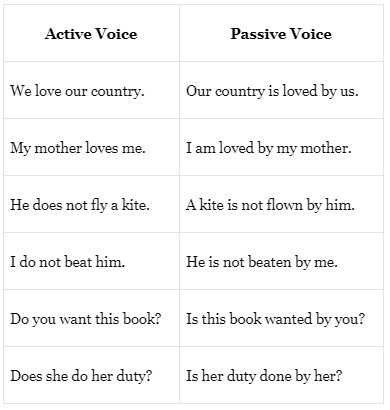
Simple Past Tense
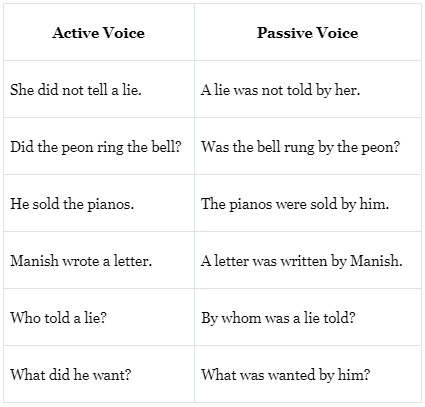
Simple Future Tense
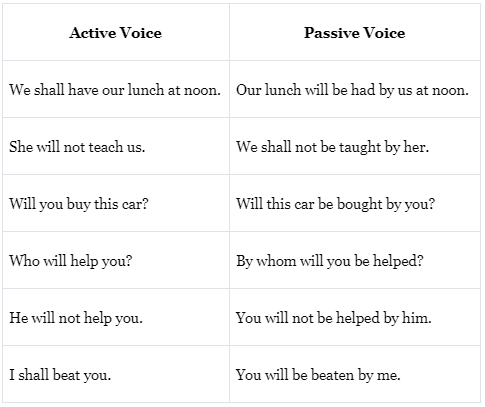
Present Continuous Tense
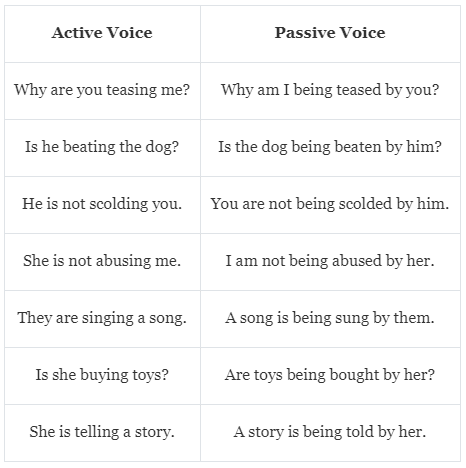
Past Continuous Tense
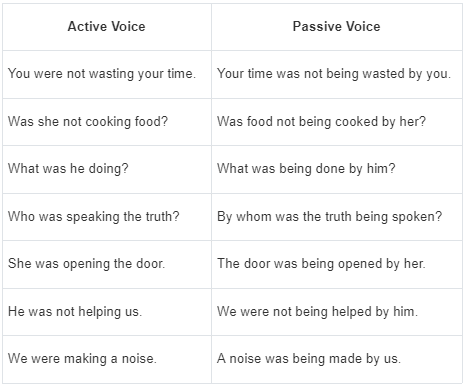
The document The Active And Passive Voice | English Grammar Class 7 is a part of the Class 7 Course English Grammar Class 7.
All you need of Class 7 at this link: Class 7
|
39 videos|288 docs|61 tests
|
FAQs on The Active And Passive Voice - English Grammar Class 7
| 1. What is the difference between active and passive voice? |  |
Ans. In active voice, the subject of the sentence performs the action, while in passive voice, the subject receives the action. For example, in the active voice sentence "John ate the apple," John is the subject and he performs the action of eating. In the passive voice sentence "The apple was eaten by John," the apple is the subject and it receives the action of being eaten.
| 2. How do I change a sentence from active to passive voice? |  |
Ans. To change a sentence from active to passive voice, you need to make the object of the active sentence the subject of the passive sentence, and use the appropriate form of the verb "to be" along with the past participle of the main verb. For example, to change the active voice sentence "She wrote the letter" to passive voice, you would say "The letter was written by her."
| 3. Why is passive voice sometimes used in writing? |  |
Ans. Passive voice is used in writing for various reasons. It is often used when the subject performing the action is unknown, unimportant, or when the focus is on the object or the action itself rather than the subject. Passive voice can also be used to create a more formal or impersonal tone, or to emphasize the receiver of the action rather than the doer.
| 4. Is it always better to use active voice in writing? |  |
Ans. While active voice is generally preferred in writing as it is more direct, clear, and engaging, there are situations where passive voice can be more appropriate. Passive voice can be used to shift the focus, create a more formal tone, or when the doer of the action is unknown or unimportant. It is important to use active or passive voice depending on the context and purpose of the writing.
| 5. How can I identify passive voice in a sentence? |  |
Ans. Passive voice can be identified by the use of the verb "to be" (such as "is," "was," "were") followed by the past participle of the main verb. Additionally, the subject receiving the action is usually placed before the verb, whereas in active voice, the subject performing the action is placed before the verb. For example, in the sentence "The book was written by the author," "was written" is in the passive voice.
Related Searches
















